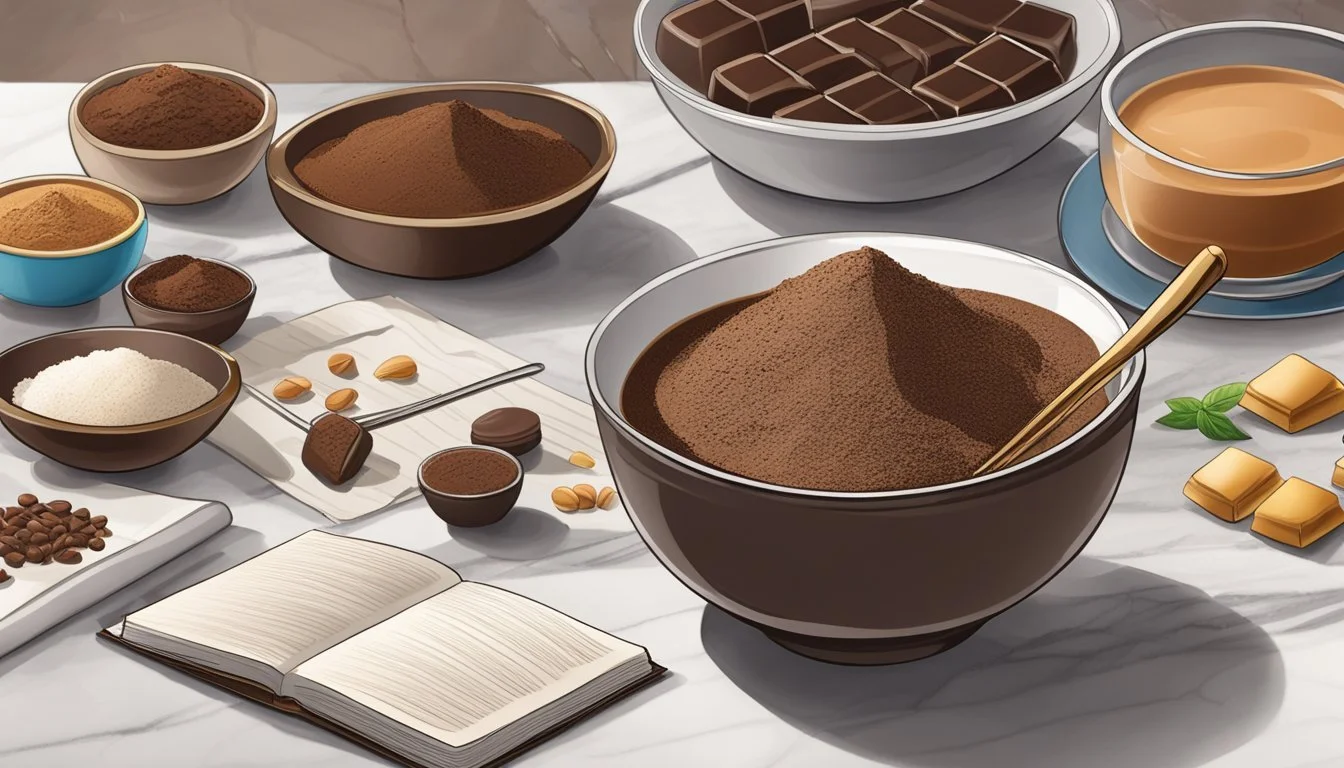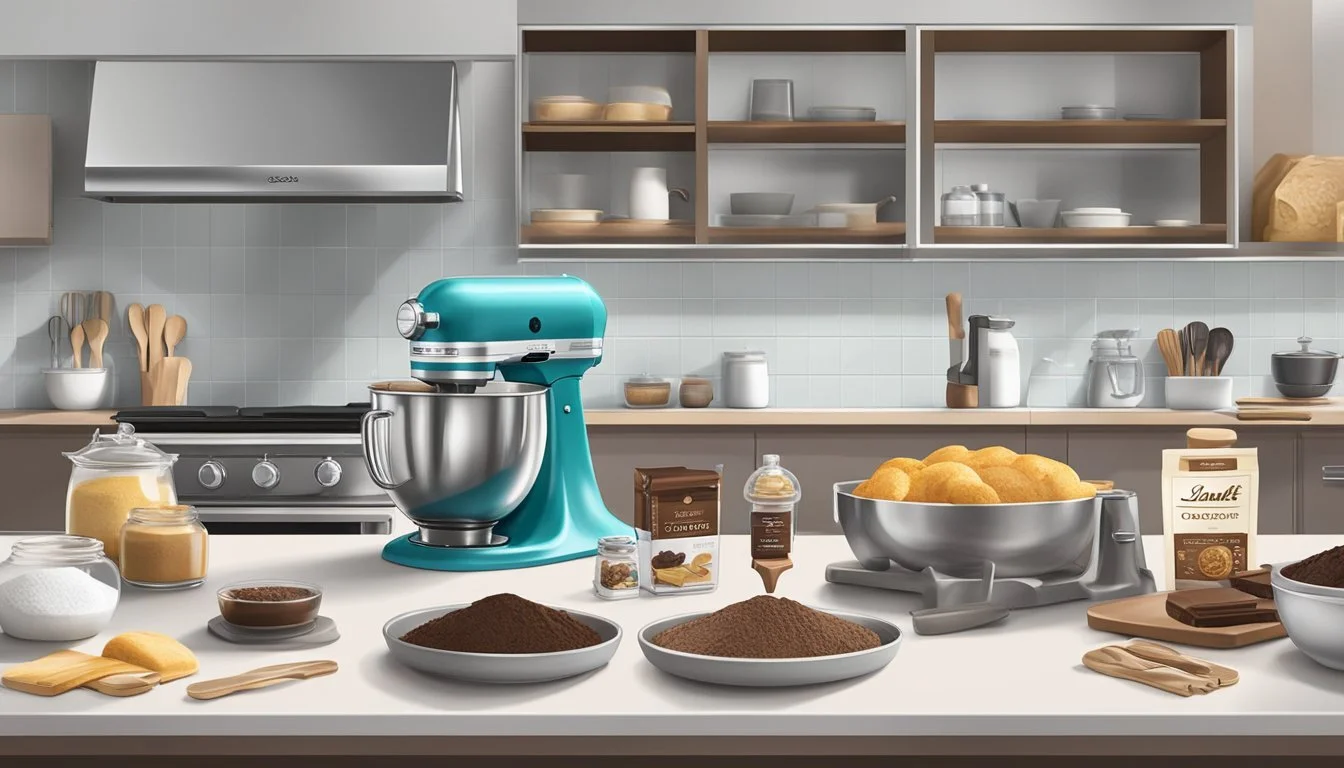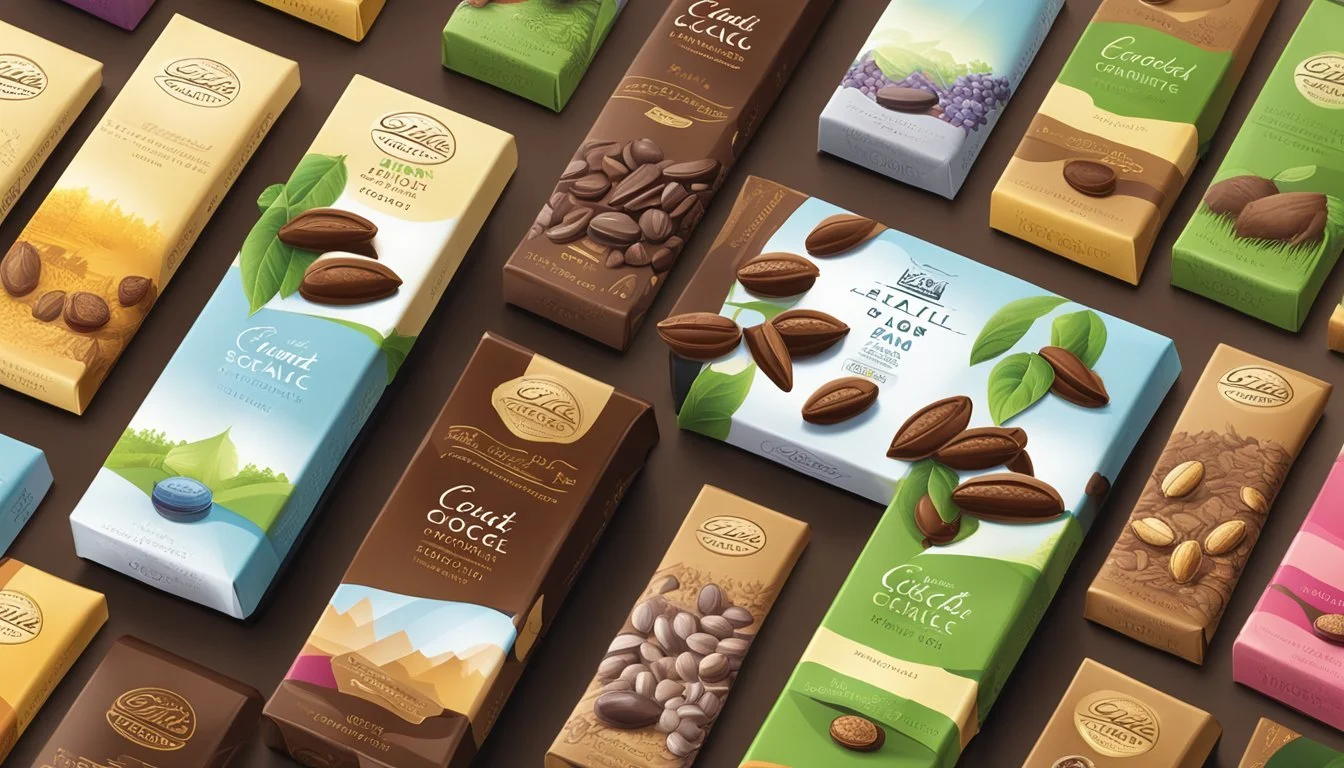How to Cook with Lindt Chocolate
Creating Decadent Desserts at Home
Cooking with Lindt chocolate (What wine goes well with chocolate?) can transform a simple dessert into an opulent treat, elevating the culinary experience with its rich flavor and superior quality. Lindt offers a diverse range of chocolate options, each suited to different types of desserts (What wine goes well with desserts?). Whether one opts for the smooth Lindor White Chocolate Truffles (What wine goes well with truffles?), the intense flavor of the Excellence Dark 70% Bar, or the delicate taste of the Excellence White Vanilla Bar, Lindt chocolate provides a luxurious foundation for a variety of dessert creations.
The process of cooking with chocolate is an art that requires attention to detail, especially when working with high-quality ingredients such as Lindt. Temperature plays a critical role; allowing the chocolate to melt slowly and avoid scorching ensures a silky, smooth result. This is crucial when preparing decadent Lindt chocolate-based desserts such as chocolate mousse, chocolate cheesecakes, or sumptuous chocolate cakes.
These luxurious desserts, rich with the complex flavors of Lindt chocolate, are bound to impress. By skillfully pairing Lindt's chocolate offerings with complementary ingredients, one may craft desserts that are not only visually stunning but also provide an extraordinary taste experience. Whether it's for a special occasion or just to indulge in a little luxury, desserts made with Lindt chocolate are sure to be a memorable affair.
Understanding Chocolate Types
When cooking with Lindt chocolate, chefs and connoisseurs must discern between various types of chocolate to ensure their desserts embody the intended flavors and textures. Lindt offers a distinguished range of chocolates, including dark chocolate, milk chocolate, and white chocolate, each with unique characteristics suitable for different culinary creations.
Dark chocolate is celebrated for its robust cocoa flavor, which comes from a higher percentage of cocoa solids. Lindt dark chocolate, for instance, often contains 65% cacao or more, making it an ideal choice for savory dishes or desserts seeking a pronounced chocolate taste.
Milk chocolate provides a sweeter, milder taste as it includes milk powder or condensed milk in addition to the chocolate liquor. It is preferred for its creamy texture and is the most widely consumed chocolate type worldwide. Milk chocolate from Lindt delivers a smooth and velvety experience, often chosen for more traditional desserts.
White chocolate does not contain cocoa solids but is made up of cocoa butter, sugar, and milk derivatives. It is known for its rich, sweet flavor and lends itself well to lighter, subtler desserts. Though newer than its counterparts, white chocolate has made a significant impact on the culinary scene since its inception.
In summary, selecting from Lindt's variety requires an understanding of the flavor profile and melting points for each chocolate type:
Dark Chocolate: Best for a strong cocoa flavor, minimal sweetness. Ideal for complex taste layers.
Milk Chocolate: Creamy and sweet, used in many classic dessert recipes.
White Chocolate: Sweet and buttery, perfect for delicate flavor compositions.
When cooking with these chocolates, it is essential to manage the temperature carefully, as high heat can cause any chocolate to burn, diminishing its fine qualities.
Essential Ingredients
Crafting sumptuous desserts with Lindt chocolate begins with selecting high-quality ingredients. Each component plays a crucial role in creating flavors and textures that complement the smooth and luxurious characteristics of Lindt chocolate.
Chocolates and Variants
Lindt Lindor White Chocolate Truffles (200g)
Lindt Excellence Dark 70% Bar (100g)
Lindt Excellence White Vanilla Bar (100g)
Extra Creamy Milk Chocolate EXCELLENCE Bar (3.5 oz)
70% Cocoa Dark Chocolate EXCELLENCE Bar (3.5 oz)
Intense Orange Dark Chocolate EXCELLENCE Bar (3.5 oz)
Lindt offers a diverse range of chocolate options suitable for different recipes. The ultra-smooth Lindt Lindor truffles can be incorporated into mousse or ganache, while bars like the Lindt Excellence Dark 70% provide depth for more intense dessert experiences.
Dairy and Alternatives
Milk: Integral for ganache or chocolate-based sauces.
Double Cream/Whipped Cream: Adds richness to mousse and cream fillings.
Salted Butter: Enhances flavor and lends creaminess to chocolate mixtures.
Vegan Alternatives: Coconut milk or almond milk can substitute for dairy in vegan recipes.
The choice of dairy impacts the creaminess and texture of desserts. Double cream yields a luxurious mouthfeel, while whipped cream adds lightness. Salted butter not only contributes to the richness but also provides a subtle contrast with its saline touch.
Sweeteners and Flavor Enhancers
Caster Sugar: Dissolves easily for a smooth dessert base.
Icing Sugar: Ideal for frosting or dusting finished desserts.
Vanilla Extract: Complements chocolate with its warm, aromatic profile.
Cocoa Powder: Intensifies the chocolate flavor in baked goods.
Sweeteners like caster sugar and icing sugar are essential for balancing the bitterness of dark chocolate. Vanilla extract is another key flavor enhancer, lending an aromatic sweetness that pairs well with milk and white chocolates.
Additional Ingredients
Eggs: A binding agent in cakes and custards.
Flour: Provides structure for baked desserts.
Peanut Butter: Adds a creamy texture and nutty flavor to chocolate recipes.
Sea Salt: A pinch can amplify the cocoa flavors.
Coffee: Deepens chocolate richness, especially in dark chocolate desserts (What wine goes well with chocolate desserts?).
Eggs and flour are foundational for various chocolate-based pastries and cakes. Incorporating peanut butter can create a satisfying contrast in textures and flavors, and sea salt is often the secret ingredient that highlights the complexity of chocolate. A hint of coffee can enhance the depth of the dessert's taste, especially when paired with robust dark chocolates.
Preparation Techniques
In crafting luxurious desserts with Lindt chocolate, precision in preparation is paramount. The chocolate's quality is enhanced through proper melting, mixing, and baking techniques, ensuring that the final presentation is as visually appealing as it is palatable.
Melting and Tempering
To melt Lindt chocolate, one must carefully manage the temperature. For dark chocolate, a medium heat is suitable, ensuring that the chocolate does not exceed 65% cacao content for savory applications. Tempering is vital when creating a glossy finish and snapping texture for decorations. It involves heating and then cooling the chocolate to stabilize it, typically requiring a chocolate thermometer to monitor the precise temperature.
Temperature Stage Dark Chocolate Milk Chocolate White Chocolate Melting 45-50°C 40-45°C 40-45°C Cooling 27-28°C 26-27°C 26-27°C Reheating 31-32°C 29-30°C 29-30°C
Mixing and Whisking
When mixing melted chocolate into dessert recipes like cheesecake, it is essential that it is combined with medium difficulty ingredients like cream cheese and icing sugar until smooth. One should whisk gently to avoid incorporating too much air which can affect the texture. For airy textures like mousse, one may whisk melted chocolate with butter or fold it into whipped cream to achieve the desired fluffiness.
Baking and Setting
Baking desserts with Lindt chocolate requires precise oven temperatures, generally preheated to moderate levels (325°F to 350°F for cakes). Timing is crucial to prevent burning, with most chocolate desserts setting upon cooling. To ensure even baking, the contents should be distributed uniformly and checked regularly.
Decoration and Presentation
The final flourish of any dessert utilizing Lindt chocolate lies in its decoration and presentation. Shards of tempered chocolate, crafted by spreading melted chocolate thinly and cutting, make for a sophisticated garnish. Edible adornments like sprinkles, marshmallows, and peppermint candies, delicately placed, complement the chocolate's rich flavor and add textural contrast. The decoration should enhance the dessert without overwhelming the inherent luxury of the chocolate.
Recipe Collection
This section comprehensively introduces a curated collection of recipes, focusing on the use of Lindt chocolate to craft both timeless classics and innovative desserts. The recipes range from simple and easy to more ambitious creations, suitable for various seasons and festivities.
Classic Lindt Desserts
Lindt Dark Chocolate Bundt Cake: For those who appreciate the deep, robust flavors of dark chocolate, a bundt cake made with Lindt's Excellence Dark 70% Bar is a must-try. This simple recipe results in a luxurious dessert that effortlessly elevates any dining occasion.
Lindt Milk Chocolate Lamingtons: An easy 40-minute recipe transforms the Lindt Swiss Classic Milk Chocolate Bar into exquisite lamingtons, offering a tender crumb enveloped in a luscious chocolate coating, perfect for spring gatherings or as a delightful everyday treat.
Innovative Creations
LINDOR Thumbprint Cookies: Embark on a creative baking journey with these indulgent cookies featuring Lindt LINDOR Milk Chocolate Truffles. Ready in just 14 minutes, these treats strike a balance between innovation and simplicity, ideal for the busy chocolate aficionado.
Chocolate Chia Pudding: Combining health-conscious trends with indulgence, this pudding utilizes Lindt Excellence 70% Cacao Dark Chocolate Bar to deliver a rich, yet nutritious, chocolate experience. It stands as a testament to how Lindt chocolate can adapt to suit more ambitious, wellness-oriented desserts.
Seasonal Specialties
Double Chocolate and Crunchy Nut Christmas Biscuits: With the festive season comes the opportunity to savor Lindt Lindor White Chocolate Truffles in these sumptuous biscuits. They are easy to make and deliver a blend of smooth white chocolate and crunchy nuts, echoing the joy of Christmas.
Orange Chocolate Cheesecake: Utilizing the Intense Orange Dark Chocolate EXCELLENCE Bar, this recipe is a celebration of Easter flavors. Made to serve 10-12 people, this medium-level creation combines zesty orange and rich dark chocolate, perfect for a springtime dessert table.
The recipes highlighted above showcase the versatility of Lindt chocolate across various desserts. Whether one opts for dark, milk, or white chocolate, each recipe presents an opportunity to explore the luxurious essence of Lindt in creating memorable culinary experiences throughout the year.
Pairing with Beverages
Pairing fine chocolates with the right beverages can elevate a dessert experience significantly. For those who enjoy Lindt's dark chocolates, such as the Lindt Excellence 90% bar, a full-bodied Malbec wine is an exceptional choice. The deep floral and dark fruit notes of Malbec, like blackberry and cherry, complement the intense and silky warmth of the high-cocoa content chocolate.
For a non-alcoholic alternative, coffee can be artfully paired with chocolate. A robust espresso balances the richness of Lindt's chocolate, particularly their darker varieties. The bitterness of both coffee and dark chocolate can enhance each other, allowing their fruity and earthy notes to shine.
For those who prefer the sweeter touch of Lindt's Extra Creamy Milk Chocolate, a lighter, fruit-forward beverage is advised. A dessert wine or a lightly sweetened latte can pair well, as milk in both the chocolate and the coffee softens any astringent notes, allowing the creaminess to be at the forefront.
Below is a summarized table of pairings:
Lindt Chocolate Type Beverage Pairing Dark, High-Cocoa Content (90%) Full-Bodied Red Wine (Malbec) Extra Creamy Milk Chocolate Dessert Wine or Latte General Dark Chocolate Espresso
When pairing chocolates with beverages, attention must be paid to the intensity and flavor notes of both components to ensure a harmonious match.
Dessert Preparation for Events
When preparing desserts for events, selecting high-quality ingredients like Lindt chocolate and tailoring the dessert complexity to the occasion ensures both elegance and guest satisfaction.
Intimate Gatherings
For intimate gatherings such as a small dinner party or a birthday celebration, luxury is in the details. One can create a memorable experience by using Lindt Lindor White Chocolate Truffles or a Lindt Excellence Dark 70% Bar to craft personalized treats. An easy yet sophisticated option is a classic chocolate fondant, where the smoothness of Lindt chocolate ensures a rich, molten center.
Spring Dinners: Opt for white or milk chocolate to complement the lightness of the season.
Autumn Birthdays: Choose dark chocolate to echo the deeper flavors popular in cooler months.
Festive Occasions
Festive occasions like Easter or Christmas call for desserts that are both a feast for the eyes and the palate. Utilizing Lindt Chocolate in seasonal specialties creates a sense of celebration. A gingerbread house adorned with Lindt chocolates or a Dark Chocolate Bundt Cake can serve as a stunning centerpiece to a Christmas table.
Christmas: Incorporate Lindt truffles into your dessert for a rich, indulgent element.
Easter: Utilize the variety of Lindt chocolate eggs to add festive flair to Easter desserts.
Casual Affairs
Casual affairs such as any get-together or impromptu seasonal party benefit from easy-to-make yet appealing desserts. Desserts like chocolate mousse or a chocolate dessert ball made with Lindt Lindor are not only simple to prepare but also universally appreciated. They cater to various tastes and can be dressed up or down depending on the casualness of the event.
Summer Events: Serve a chilled Lindt chocolate mousse to offer respite from the heat.
Winter Gatherings: A hot berry chocolate sauce with Lindt chocolate creates a comforting treat.
By considering the occasion, one can choose a Lindt chocolate-based dessert that complements the event's atmosphere while ensuring that each guest's sweet tooth is thoroughly indulged.
Storage and Shelf Life
Proper storage of Lindt chocolate is crucial to maintain its quality and extend its shelf life. Lindt chocolate should be stored at a temperature between 60° and 68° Fahrenheit, in a cool, dry place away from any sources of heat or light. This environment ensures that the chocolate's texture and flavor remain intact.
Shelf Life:
On the counter: Lindt chocolates can last for 1 to 2 months.
In the pantry: Ensure chocolates are kept away from strong-smelling foods, as chocolate can absorb odors.
Storage Tips:
Temperature: Keep at 60°-68°F.
Humidity: Store in low humidity to prevent sugar bloom, which occurs when sugar crystallizes on the chocolate's surface.
Odors: Chocolate absorbs external odors, so it should be kept in a sealed container.
Frozen Storage: Freezing Lindt chocolate is not generally recommended, as it can alter the texture and lead to condensation, which affects the taste and quality.
Raw Ingredients: If the Lindt chocolate is to be used as a raw ingredient in desserts, preserving its quality through proper storage is essential. The chocolate's character and flavor profile can significantly influence the finished dessert.
To maintain the luxurious quality of Lindt chocolate, adherence to storage guidelines can ensure that each dessert crafted from these fine chocolates expresses the indulgence that Lindt is known for.
Dietary Considerations
Catering to specific dietary needs ensures that luxurious desserts made with Lindt chocolate can be enjoyed by a wider audience. Attention to ingredients is essential, as is the selection of suitable Lindt chocolate varieties to match dietary restrictions.
Vegan Alternatives
Lindt may offer certain dark chocolate options that are suitable for vegans, but consumers must check the ingredient list for items like milk, which is common in many chocolate products. For a strictly vegan dessert, one should look for chocolates explicitly labeled as vegan. Alternatives for other non-vegan ingredients include:
Milk: Use almond, soy, or oat milk.
Butter: Opt for plant-based butters or coconut oil.
Cream: Coconut cream or vegan whipped cream substitutes.
Gluten-Free Options
Many Lindt chocolate products are naturally gluten-free, such as their high-quality dark chocolates. However, it's important to always verify this on the packaging due to potential cross-contamination risks. For gluten-free desserts, ensure all ingredients are labeled gluten-free, particularly:
Flour: Use almond, rice, or a specific gluten-free blend.
Binding agents: Consider xanthan gum or guar gum as replacements for gluten's textural properties.
Always review the latest product information and consult with Lindt for the most accurate allergen and ingredient listings.
Advanced Chocolate Techniques
When venturing into the realm of luxurious desserts with Lindt chocolate, certain advanced techniques may elevate the end result. Mastery over these methods can significantly enhance the flavor and texture of the dessert.
Tempering is a critical technique for achieving a glossy and crisp finish on chocolate confections. It involves carefully heating and cooling Lindt chocolate to stabilize the cocoa butter crystals. The process starts with melting the chocolate until it reaches a temperature of about 49°C, followed by a cooling phase to 27°C, and then gently reheating to 32°C.
In the preparation of chocolate mousse, incorporating egg yolks is crucial for a rich and creamy consistency. To avoid curdling the yolks, chefs often employ the method of tempering by gradually adding a small amount of hot chocolate to the yolks, whisking constantly, before combining everything back into the main mixture.
Using cocoa powder can intensify the chocolate essence in desserts. It should be sifted to prevent lumps and can be combined with a touch of cornstarch to create a thick and decadent Italian hot chocolate. Higher percentages of cocoa in chocolate provide a more profound flavor suitable for such recipes.
When creating sauces or pastry fillings, chefs use cornstarch as a thickening agent to achieve the desired consistency. For a smooth chocolate crème anglaise, they often mix cornstarch with a bit of cold whole milk to prevent clumps before incorporating it into the hot liquid.
Ingredient Use in Technique Tempered Chocolate Molding and Coating Egg Yolks Emulsion for Mousse Cocoa Powder Intensifying Flavor Cornstarch Thickening Agent for Sauces and Hot Chocolate
Each of these techniques requires precision and patience, but the outcome is a refined and luscious dessert that showcases the full potential of fine Lindt chocolate.
Lindt Chocolate as a Luxury Gift
Lindt chocolate, recognized for its smoothness and rich flavors, is considered a luxurious treat by connoisseurs across the globe. Their Lindor truffles specifically have become synonymous with luxury, offering a melt-in-the-mouth experience that's hard to replicate. When looking for a sophisticated gift, Lindt's premium chocolates are an impeccable choice.
Presenting Lindt chocolates as a gift conveys a message of appreciation and high regard. The elegance of the packaging coupled with the exquisite taste profiles makes it a staple for those who wish to leave a lasting impression. The range of offerings is vast, ensuring that there's a perfect match for any preference or occasion.
For gifting, one might consider:
Assorted Truffle Boxes: Varied flavors to please any palate.
Custom Selections: Handpicked favorites to show thoughtfulness.
Seasonal Specialties: Limited edition chocolates for a unique experience.
Gift Type Features Box of Truffles Contains an assortment of Lindor truffle flavors Customized Box Personalized selection to match the recipient's tastes Specialty Items Seasonal and limited edition chocolates
When gifting Lindt, one is not just offering sweets but an experience that's rich with tradition, craftsmanship, and exceptional quality. Whether as a heartfelt thank you, a romantic gesture, or a celebratory token, Lindt chocolate is both a classic and luxurious choice that communicates care and sophistication.
The History of Lindt and Its Impact on Confectionery
Lindt has been synonymous with fine chocolate since the late 19th century, with a history deeply intertwined with the evolution of confectionery. The company's roots reach back to 1845, when Swiss confectioner David Sprüngli-Schwarz and his son, Rudolf Sprüngli-Ammann, sought to craft chocolate with an enduring shape and texture, which gained popularity in Zurich.
The year 1879 marked a significant milestone for Lindt when Rodolphe Lindt, then a young confectioner from Berne, improved the chocolate-making process with his invention of conching. This pivotal technique involved the continuous stirring and aerating of chocolate to refine its texture and flavor, transforming the once hard, bitter chocolate into something unrivaled in smoothness and taste.
Impact of Lindt in Chocolate Confectionery
Quality: Raised the standard for chocolate products, providing a superior, melt-in-the-mouth experience.
Innovation: Lindt's creativity, exemplified by the invention of the LINDOR truffle in 1949, set the stage for a variety of enticing flavors that have become staples in their product range.
Variety: Beginning with the LINDOR Milk, Lindt has expanded its flavor offerings to include varieties such as Dark, White, and Hazelnut chocolates.
Lindt's dedication to confectionery excellence has had a lasting impact, pushing the boundaries of what constitutes luxury in chocolate offerings. Their techniques have influenced countless chocolatiers and raised consumer expectations, helping to shape the industry into what it is today—an artful blend of tradition and culinary innovation.
Understanding the Sustainability Efforts of Lindt
Lindt recognizes the fundamental role of high-quality cocoa in their chocolate products. Sustainability is a cornerstone of their business practice, particularly in cocoa sourcing. They have established the Lindt & Sprüngli Farming Program to secure a responsible supply chain. This initiative is focused on improving the living conditions of farmers and ensuring the resilience of their livelihoods.
Key Goals:
Transparency: Lindt strives to maintain clarity in their supply chain by understanding where their cocoa beans originate, who cultivates them, and the methods used in their production.
Quality and Responsibility: Aside from ensuring the outstanding taste of its chocolate, Lindt aims to uphold ethical standards and alignment with sustainable practices in the selection and cultivation of cocoa beans.
Progress & Commitment:
Lindt has set a target to source 100% of cocoa products sustainably by 2025.
As of 2023, they have reported sourcing 68.2% of their cocoa bean equivalents through their Farming Program.
Lindt's sincere efforts extend beyond bean sourcing. The company is actively engaged in addressing structural issues in cocoa-producing regions, including combating poverty, hunger, and enhancing education opportunities.
The sustainable approach adopted by Lindt is not just beneficial for the environment and the farming communities but also assures consumers of ethically-produced luxury desserts. Through these robust efforts, Lindt demonstrates a steadfast commitment to sustainability, without compromising on the quality of chocolate that customers relish.
Comparing Lindt with Other Premium Chocolate Brands
When choosing a premium chocolate for desserts, brand comparison is valuable. Lindt is often favored for its Lindt Excellence range, characterized by a variety of cacao percentages and nuanced flavor infusions. The brand's commitment to sustainability and ethical sourcing is significant, appealing to conscious consumers.
Brand Texture Flavor Profile Cacao Content Ethical Sourcing Lindt Smooth Balanced 50-99% Yes Godiva Creamy Sweeter Varied Not specified
Godiva stands out for its indulgent, creamy texture and sweeter taste. In contrast, Lindt is typically recognized for its velvety smoothness and balanced flavor. They vary in cacao content, with Lindt offering a broad range explicitly suited for both sweet and savory dishes.
In comparison with other brands, Lindt's dedication to high-quality ingredients is notable. Their Excellence line, particularly with dark chocolates that exceed 65% cacao, is suitable for cooking, where temperature control is critical to prevent burning.
As chocolate aficionados choose premium brands, influences of flavor, texture, and production practices weigh in their decision. They look at each brand for unique characteristics and match them with their cooking or baking needs. The comparison among premium chocolate brands like Lindt depends on individual consumer preferences, which are shaped by the intended use, ethical considerations, and taste profile desired.
The Future of Chocolate: Trends and Innovations
In the realm of chocolate, the future is shaped by distinct trends and innovations that cater to evolving consumer preferences. One such trend is the emergence of Mood Food, which incorporates ingredients known to enhance wellbeing, dovetailing the desire for indulgence with health consciousness.
Sustainability continues to be at the forefront, with many chocolate companies now prioritizing Sustainable Farming practices. These practices include ethical sourcing and the use of eco-friendly packaging, underpinning a commitment to the planet and fair compensation for farmers.
With a surge in dietary diversity, the Plant-Based movement is sprouting in the chocolate industry as well. Chocolates derived from non-dairy sources are becoming increasingly popular, allowing those with dietary restrictions to savor luxurious desserts without compromise.
Technological advancements are also revolutionizing chocolate production. Companies like Vulcanotec are driving the future of chocolate with state-of-the-art cocoa and chocolate processing machines, which promise to enhance quality and efficiency in production.
The innovations in how chocolate is crafted open new opportunities for chefs and culinary enthusiasts to explore. For instance, when cooking with high-quality Lindt chocolate, it is vital to select chocolates with 65% cacao or higher for savory dishes and to manage temperatures meticulously to prevent burning.
This trend-aware and innovation-rich future assures chocolate lovers that their favorite treat will continue to delight in new and sustainable ways.












